


V-22 Osprey
 The V-22 Osprey is a tiltrotor vertical/short takeoff and landing (VSTOL), multi-mission air-craft developed to fill multi-Service combat operational requirements. The MV-22 will replace the current Marine Corps assault helicopters in the medium lift category (CH-46E and CH-53D), contributing to the dominant maneuver of the Marine landing force, as well as supporting focused logistics in the days following commencement of an amphibious operation. The Air Force variant, the CV-22, will replace the MH-53J and MH-60G and augment the MC-130 fleet in the USSOCOM Special Operations mission. The Air Force requires the CV-22 to provide a long-range VTOL insertion and extraction capability. The tiltrotor design combines the vertical flight capabilities of a helicopter with the speed and range of a turboprop airplane and permits aerial refueling and world-wide self deployment.
The V-22 Osprey is a tiltrotor vertical/short takeoff and landing (VSTOL), multi-mission air-craft developed to fill multi-Service combat operational requirements. The MV-22 will replace the current Marine Corps assault helicopters in the medium lift category (CH-46E and CH-53D), contributing to the dominant maneuver of the Marine landing force, as well as supporting focused logistics in the days following commencement of an amphibious operation. The Air Force variant, the CV-22, will replace the MH-53J and MH-60G and augment the MC-130 fleet in the USSOCOM Special Operations mission. The Air Force requires the CV-22 to provide a long-range VTOL insertion and extraction capability. The tiltrotor design combines the vertical flight capabilities of a helicopter with the speed and range of a turboprop airplane and permits aerial refueling and world-wide self deployment.
Two 6150 shaft horsepower turboshaft engines each drive a 38 ft diameter, 3-bladed proprotor. The proprotors are connected to each other by interconnect shafting which maintains proprotor synchronization and provides single engine power to both proprotors in the event of an engine failure. The engines and flight controls are controlled by a triply redundant digital fly-by-wire system.
The airframe is constructed primarily of graphite-reinforced epoxy composite material. The composite structure will provide improved strength to weight ratio, corrosion resistance, and damage tolerance compared to typical metal construction. Battle damage tolerance is built into the aircraft by means of composite construction and redundant and separated flight control, electrical, and hydraulic systems. An integrated electronic warfare defensive suite including a radar warning receiver, a missile warning set, and a countermeasures dispensing system, will be installed.
BACKGROUND INFORMATION
The V-22 is being developed to meet the provisions of the April 1995 Joint Multi-Mission Vertical Lift Aircraft (JMVX) Operational Requirements Document (ORD) for an advanced vertical lift aircraft. The JMVX ORD calls for an aircraft that would provide the Marine Corps and Air Force the ability to conduct assault support and long-range, high-speed missions requiring vertical takeoff and landing capabilities.
Since entry into FSD in 1986, the V-22 T&E program has concentrated principally on engineering and integration testing by the contractors. Three periods of formal development test by Naval Air Warfare Center-Aircraft Division (NAWCAD) Patuxent River, plus OTA participation in integrated test team (ITT) activities at Patuxent River, have provided some insight into the success of the development effort. After transition to EMD in 1992, an integrated contractor/government test team conducted all tests until OT-IIA in 1994. Since then, two additional periods of OT&E have been conducted.
The first operational test period (OT-IIA) was performed by COMOPTEVFOR, with assistance from AFOTEC, from May 16 to July 8, 1994, and accomplished 15 hours of actual flight test operations, within an extremely restricted flight envelope. The Navy, with Air Force support, published a joint evaluation report addressing most mission areas the V-22 is to perform.
OT-IIB was conducted from September 9, to October 18, 1995, and comprised 10 flight hours in 18 OT&E flights, plus ground evaluations. A joint Air Force/Navy OT-IIB report was published. Partly in response to DOT&E concern expressed over the severity of V-22 downwash in a hover observed during OT-IIA, the Navy conducted a limited downwash assessment concurrently with OT-IIB, from July to October 1995.
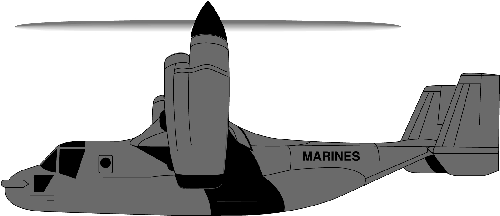
TEST & EVALUATION ACTIVITY
In accordance with the approved TEMP, OT-IIC was conducted in six phases at NAS Patuxent River and Bell-Boeing facilities in Pennsylvania and Texas, from October 1996, through May 1997.
Significant flight limitations were placed on the FSD V-22 in OT&E to date, including:
- not cleared to hover over unprepared landing zones until OT-IIC
- no operational internal or external loads or passengers
- moderate gross weights only
- not cleared to hover over water.
In addition, FSD aircraft equipment was not representative of any mission configuration. Together, these aircraft clearance and configuration limits produced an extremely artificial test environment for OT-IIC.
The OT-IIB report expressed serious concerns regarding the potential downwash effects, and recommended further investigation. While a limited assessment of downwash and workaround procedures was included in OT-IIC, complete resolution of the downwash issue will not be possible until the completion of OPEVAL, just prior to milestone III in 1999.
The Navy is conducting an aggressive LFT&E program on representative V-22 components and assemblies, in compliance with a DOT&E-approved alternative LFT&E plan. The V-22 program was granted a waiver from full-up, system-level LFT&E in April, 1997. The vulnerability testing that the program is performing is appropriate and will result in the improvement of aircraft survivability.
The V-22 program TEMP was last approved by DOT&E on September 28, 1995, and will be updated prior to each OT&E period scheduled.
TEST & EVALUATION ASSESSMENT
With DOT&E encouragement, the Navy greatly expanded the scope of OT-IIC to get better insight into the effectiveness and suitability of the EMD design. The results, while not yet conclusive regarding the potential operational effectiveness and suitability of operational aircraft, were encouraging. The six phases of the OT-IIC Assessment included: (1) shipboard assessment, (2) maintenance demonstrations, (3) tactical aircraft employment via FSD aircraft and manned flight simulator, (4) operational training plans, (5) program documentation review, and (6) software analysis.
In assessing the operational effectiveness and suitability COIs, COMOPTEVFOR and AFOTEC found that in most cases, only moderate risk exists that the COIs will not be satisfactorily resolved when development is complete. Enhancing features observed during OT-IIC included aircraft payload, range and speed characteristics better than the stated operational requirements. In addition, reliability, availability and maintainability of the EMD aircraft appeared to be significantly improved over those of the FSD aircraft.
Several areas of concern first discovered in OT-IIA or OT-IIB remain unresolved because of limitations to the EMD flight test operations. These concerns include severe proprotor downwash effects during personnel insertion and extraction via hoist or rope. In addition, concerns exist in the areas of communications, navigation , and crew field of view. New concerns arising from OT-IIC regarding the EMD schedule are being addressed by the program manager. Also, the reliability and maintainability of a few subsystems will require management attention. Despite these concerns, the V-22 design remains potentially operationally effective and suitable.
The aircraft's prime contractors include Boeing Company's helicopter division in Ridley Park, PA, and Bell Helicopter Textron of Fort Worth TX.
In 1986 the cost of a single V-22 was estimated at $24 million, with 923 aircraft to be built. In 1989 the Bush administration cancelled the project, at which time the unit cost was estimated at $35 million, with 602 aircraft. The V-22 question caused friction between Secretary of Defense Richard B. Cheney and Congress throughout his tenure. DoD spent some of the money Congress appropriated to develop the aircraft, but congressional sources accused Cheney, who continued to oppose the Osprey, of violating the law by not moving ahead as Congress had directed. Cheney argued that building and testing the prototype Osprey would cost more than the amount appropriated. In the spring of 1992 several congressional supporters of the V-22 threatened to take Cheney to court over the issue. A little later, in the face of suggestions from congressional Republicans that Cheney's opposition to the Osprey was hurting President Bush's reelection campaign, especially in Texas and Pennsylvania where the aircraft would be built, Cheney relented and suggested spending $1.5 billion in fiscal years 1992 and 1993 to develop it. He made clear that he personally still opposed the Osprey and favored a less costly alternative.
The program was revived by the incoming Clinton administration, and current plans call for building 458 Ospreys for $37.3 billion, or more than $80 million apiece, with the Marines receiving 360 Ospreys, the Navy 48 and the Air Force 50. The first prototype flew in 1989. As of early 2000 three test aircraft had crashed: no one was killed in the 1991 crash, an accident in 1992 killed seven men, and the third in April 2000 killed 19 Marines.
Specifications
|
| Primary function | Amphibious assault transport of troops, equipment and supplies from assault ships and land bases
|
| Prime Contractor(s) |
Boeing Defense and Space Group, Philadelphia, PA
Bell Helicopter Textron, Ft Worth, TX
Allison Engine Company, Indianapolis, IN
|
| Description | The V-22 Osprey is a multi-engine, dual-piloted, self-deployable, medium lift, vertical takeoff and landing (VTOL) tiltrotor aircraft designed for combat, combat support, combat service support, and Special Operations missions worldwide. It will replace the Corps' aged fleet of CH-46E and CH-53D medium lift helicopters
|
| Variants | CV-22 will be utilized by the Air Force for their Special Operations missions maintaining maximum commonality with the MV-22. Aircraft avionics peculiar to the Air Force unique mission requirements constitute aircraft differences. HV-22 will be used Navy the for Combat Search and Rescue and fleet logistics support.
|
| Length |
57' 4" - Spread
63' 0" - Folded
|
| Width |
84' 7" - Spread
18' 5" - Folded
|
| Height |
22' 1" - Spread
18' 1" - Folded
|
| Takeoff Weights |
47,500 lb Vertical Takeoff/Landing (VTOL)
55,000 lb Short Takeoff/Landing (STOL)
60,500 lb Self Deploy STO
|
| Range |
200nm Pre-Assault Raid with 18 troops
200nm Land Assault with 24 troops
50 nm (x2) Amphibious Assault
500 nm Long Range SOF Missions (USAF/CV-22)
2100 nm Self Deploy (with one refueling)
50 nm External Lift Operations with 10,000 lb load
|
| Cruise Airspeed |
240 kts (MV-22)
230 kts (CV-22)
|
| Milestones | First Flight - March 19, 1989
First Sea Trials - USS Wasp (LHD-1), December, 1990, Aircraft # 3 & 4
First EMD Flight - February 5, 1997
2nd Sea Trials - USS Saipan (LHA-2), January, 1999, Aircraft #10
First LRIP Delivery - May 25, 1999
OPEVAL - Scheduled October, 1999 to May, 2000
Full Rate Production - First Quarter, 2001
IOC - USMC - 2001; US SOCOM - 2004 |
| Unit Cost | $40.1M (Total Program Recurring Flyaway, Constant Year, FY94$)
|
| Number Procured | 12 MV-22(authorized through FY98)
|
| Planned Inventory |
348 MV-22 (USMC)
50 CV-22 (USAF)
48 HV-22 (USN)
|
| Deployed to | MV-22s will be deployed to all Marine Corps medium lift active duty and reserve tactical squadrons, the medium lift training squadron (FRS), and the executive support squadron (HMX)
|


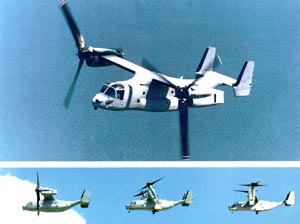
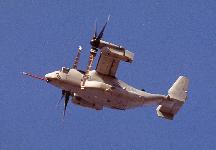

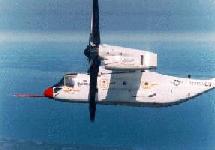
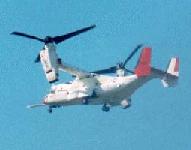
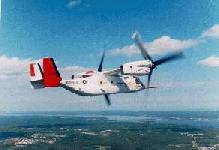
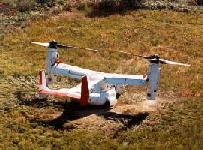
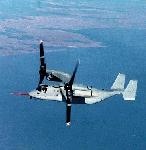
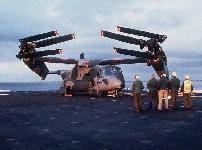


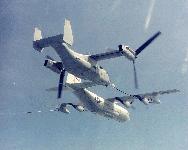
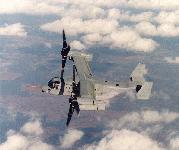
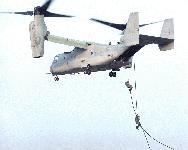
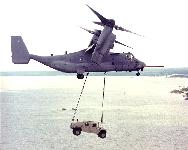
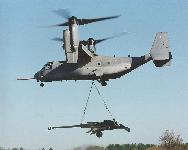
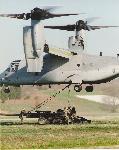
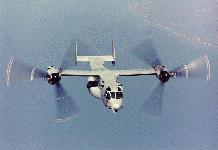
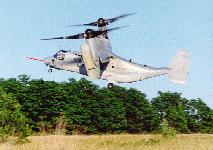
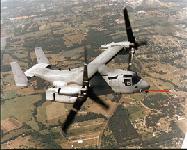
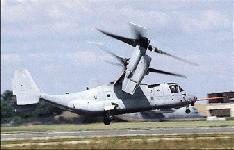
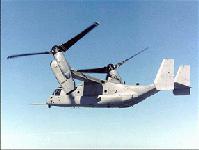
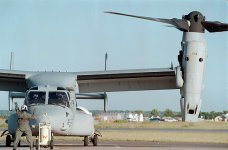
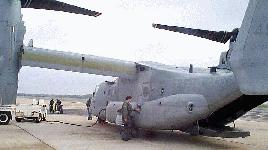
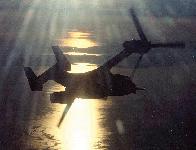
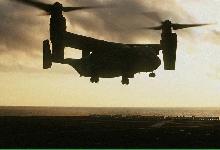
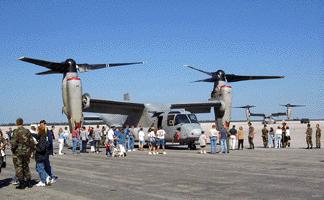
Sources and Resources
- Final Report of the Panel to Review the V-22 Program (PDF), April 2001
- Osprey Online NAVAIR PMA 275
- Boeing V-22 Osprey
- THE SPECIAL OSPREY: IMPACT ON SPECIAL OPERATIONS DOCTRINE
THOMAS J. TRASK School of Advanced Airpower Studies JUNE 1996
- The Cv-22 "Osprey" And The Impact On Air Force Combat Search And Rescue Tom P Currie Jr; Steven Purtle (Faculty Advisor) Air Command and Staff College 1999 -- Conducting the CSAR mission with the CV-22 will eradicate current mission deficiencies and enhance execution through advances in Combat Search and Rescue.
- V-22 Naval Training System Plan [PDF]
- New tiltrotor aircraft makes debut in Florida : 4 Nov 1998 - The V-22 is the forerunner of the CV-22, which AFSOC will start receiving in 2004. Eventually, AFSOC will get 50 CV-22s to replace most of its rotary and fixed-wing fleet.
- V-22 TESTS ITS SALT AT SEA V-22 Public Affairs 13 January 1999
- TILT-ROTOR AIRCRAFT TESTS ITS 'SALT' AT SEA Marine Corps News . (Jan 20, 1999) - The V-22 Osprey entered another phase of its flight test program Jan. 14 when one of the MV-22 engineering and manufacturing development (EMD) aircraft flew aboard the USS Saipan, to begin its sea trials scheduled to last until mid-February.
- FORCE STRUCTURE CHANGES PREPARE AFSOC FOR THE FUTURE Night Flyer News Service 05 March 1999 -- Air Force officials announced changes in force structures today that will affect Air Force Special Operations Command units. According to AFSOC officials, the changes are designed to help transition the command to the introduction of the CV-22 Osprey tilt-rotor aircraft into the inventory.
- NEW TECHNOLGY SAVES MILLIONS IN V-22 PROGRAM V-22 Public Affairs 09 April 1999
- V-22 OSPREY LIFTS NEW LIGHTWEIGHT HOWITZER V-22 Public Affairs 28 April 1999
- V-22 OSPREY CITED FOR EXCELLENCE IN ACQUISITION REFORM By Gidge Dady, V-22 Public Affairs (May 4) -- Dr. H. Lee Buchanan, assistant secretary of the Navy for Research, Development and Acquisition, presented the V-22 government and industry team the 1999 Department of Defense (DOD) Acquisition Executives (DAE) Certificate of Achievement for excellence in Acquisition Reform here May 3.
- V-22 Cited for Excellence in Value Engineering V-22 Public Affairs 27 May 1999
- MARINES GET FIRST PRODUCTION MV-22 V-22 Public Affairs 01 June 1999
- TILTROTOR PILOTS HONORED WITH FEINBURG AWARD V-22 Public Affairs 09 June 1999
- Work begins on CV-22 Osprey Aeronautical Systems Center Public Affairs 10 June 1999 -- An MV-22 Osprey was delivered to Bell Helicopter Textron's Arlington, Texas, facility June 7 to be re-manufactured into the CV-22, the Air Force version of the tilt-rotor aircraft.
- WORK BEGINS ON CV-22 OSPREY V-22 Public Affairs 11 June 1999
- MV-22 AND KC-10 TEAM UP FOR WAKE SURVEY TESTS V-22 Public Affairs 08 September 1999
- Tilt-rotor Technology Promises Military Revolution By Jim Garamone American Forces Press Service 08 September 1999 -- Defense Secretary William S. Cohen placed the Osprey in the same class as other systems that revolutionized warfare -- the dreadnoughts of World War I, the aircraft carriers of World War II and the fighter-bombers and unmanned aerial vehicles of Operation Allied Force over Yugoslavia.
- OSPREY SHOWS OFF ITS TECHNOLOGY AT TILTROTOR DAY DEMONSTRATION V-22 Public Affairs 14 September 1999
- MV-22 CONCLUDES SUCCESSFULl SEA TRIALS, PREPARES FOR NEXT MILESTONE
V-22 Public Affairs 01 October 1999
- MV-22 ends sea trials, prepares for final test Tester October 7, 1999 -- The V-22 government and industry integrated test team (ITT) has just concluded a successful sea trials for the engineering and manufacturing, development (EMD) MV-22 aircraft aboard two amphibious ships, USS Saipan and USS Tortuga.
- OPERATIONAL EVALUATION UNDERWAY FOR FIRST PRODUCTION TILTROTOR V-22 Public Affairs 01 November 1999
- MV-22 AIRCRAFT MISHAP CLAIMS LIVES OF 19 MARINES Marine Corps News 04/09/2000 -- The MV-22 was conducting a training mission in support of Operational Evaluation (OPEVAL) when it went down near Marana, Ariz.
- MV-22 Mishap Information
- STATEMENT ON MV-22 MISHAP BY LTGEN FRED MCCORKLE DEPUTY CHIEF OF STAFF FOR AVIATION HEADQUARTERS MARINE CORPS (11 APRIL 2000)
- Marines put Osprey on hold By Andrea Stone USA TODAY 11 April 2000 -- ''Look at the aircraft they (Marines) fly and what they do with them,'' says John Pike, a defense analyst at the Federation of American Scientists. ''They fly closer to the ground, where there is less room for the pilot to get out of trouble.''
- MV-22 ACCIDENT INVESTIGATORS FOCUS ON LOSS OF LIFT: MARINES ANNOUNCE PHASED 'RETURN TO FLIGHT' PLAN FOR OSPREYS By Division of Public Affairs, HEADQUARTERS, U.S. MARINE CORPS, WASHINGTON, DC (May 9) -- Marine Corps officials said today that a phenomenon known as "power settling" is now the focus of their investigation into the crash of an MV-22 Osprey aircraft that killed 19 Marines April 8 in Marana, Ariz.
- DoD News Briefing May 9, 2000 -- Analysis of the data retrieved from the crash survivable memory unit, or the CSMU, coupled with comprehensive engineering investigations to date have found no mechanical or software failures. Power settling is a condition which can be common to all helicopter flight, and is now the main focus of the investigation. The vortex ring state occurs when the velocity of the downwash from the rotor is approximately equal to the rate of descent of the aircraft, causing the air to recirculate up and around and back down through the rotor system. He was descending over a thousand feet per minute. The envelope of flight is recommended at not to exceed 800 feet per minute below 40 knots of air speed.
- Marines Clear Tilt-Rotor V-22 Ospreys for Flight
By Jim Garamone American Forces Press Service May 11, 2000 -- The Marine Corps will resume flying its V-22 tilt-rotor Osprey aircraft. Officials said on May 9 that an examination of data from the crash last month that claimed 19 lives did not indicate any mechanical or software failures.
- MV-22 OSPREY PRODUCTION AIRCRAFT RETURN TO FLIGHT Marine Corps News 05/25/2000 -- The Commandant of the Marine Corps, Gen. James Jones, today authorized the return of Low Rate Initial Production (LRIP) MV-22 aircraft to flight operations.
- First Cv-22 Tilt-Rotor Rolls Out, U.S. Department of Defense, 25 July 2000 -- The first CV-22 tilt-rotor aircraft, the special operations-modified version of the V-22 Osprey, was unveiled and rolled out today.
- News Briefing, U.S. Department of Defense, 27 July 2000 -- Transcript of briefing providing the results of the JAG Manual investigation into the April 8th crash of the MV-22 Osprey near Marana, Arizona, that killed 19 Marines.
- Chain of Errors Caused Fatal Osprey Crash, American Forces Press Service, 28 July 2000 -- Like "links in a chain," many things went wrong in the April 8 crash of an MV-22 Osprey that killed 19 Marines, Marine officials said.
- News Briefing, U.S. Department of Defense, 17 August 2000 -- Q: The Pentagon's Inspector General a couple of days ago came out with the final report on the V-22, the status of the program. And the overriding message of the report was that the Navy and the Marines were moving fairly quickly to a production decision, despite about 22 major deficiencies in the program that won't be fixed or haven't been fixed yet. Has DoD seen the report? And if you have, do you have a reaction to that? The implication being not all the bugs are going to be worked out of this major multibillion-dollar program before it moves into full-rate production.
- First CV-22 arrives at Edwards, Air Force Print News, 22 September 2000 -- The arrival of the first CV-22 Osprey at Edwards Air Force Base, Calif., ushers in a new era in aviation for the Air Force and U.S. Special Operations Command.
- MV-22 Declared Effective, Suitable For Land-Based Ops, U.S. Department of Defense, 13 October 2000 -- The Department of the Navy announced today that the MV-22 Osprey has been judged operationally effective and operationally suitable for land-based operations, validating eight months of comprehensive evaluation.
- Osprey gets passing grades, but more testing is urged, Stars and Stripes, 15 October 2000 -- Navy evaluators have given the new V-22 Osprey a passing grade for its land-based operational capabilities, but recommended more testing at sea before deciding whether to push the aircraft into full-scale production, Marine Corps officials said Friday.
- Pentagon Regular Briefing - V-22 Readiness, U.S. Department of Defense, 30 November 2000 -- Q: Ken, regarding a somewhat critical Coyle report on the MV- 22, does the SECDEF believe that the tilt rotor plane is ready for full-scale production and use by the Marine Corps in any situation?
- Pentagon Spokesman's Regular Briefing - V-22, U.S. Department of Defense, 05 December 2000 -- Q: Can you update the time line for the V-22 beyond LRIP [low rate initial production] decision?
- Marines / Aircraft, Voice of America, 12 December 2000 -- The future of the U-S Marine Corps' revolutionary tilt-rotor aircraft may be in doubt following another fatal crash.
- Pentagon Spokesman's Regular Briefing - V-22 Crash, U.S. Department of Defense, 12 December 2000 -- Q: Ken, is the SECDEF as assured or as confident as Marine leaders that the V-22 program is still safe and kicking? And has he received a request from the commandant to form a blue-ribbon commission to look over the whole program?
- DoD News Briefing - V-22 Crash, U.S. Department of Defense, 12 December 2000 -- Special briefing on the MV-22 Osprey crash
- Cohen to Appoint Panel to Study MV-22 Osprey , American Forces Press Service, 13 December 2000 -- Defense Secretary William S. Cohen will appoint a panel to look at the MV-22 Osprey program in the wake of the second tilt-rotor aircraft crash since early April.
- Osprey / Cheney, Voice of America, 19 December 2000 -- President-elect George Bush campaigned for office on the need for a strong military, increased defense spending and a new generation of weapons technology.
- Downed Osprey had hydraulic malfunction, By Sandra Jontz, Stars and Stripes, 23 December 2000 -- The MV-22 Osprey that crashed in North Carolina this month killing four experienced a hydraulic malfunction, according to preliminary investigation results released Thursday by the U.S. Marine Corps.
- Marines / Plane, Voice of America, 18 January 2001 -- The U-S Marine Corps is investigating allegations that maintenance records for its controversial tilt-rotor Osprey aircraft have been falsified.
- Marine Corps to Investigate Osprey Squadron , DOD News Release, 18 January 2001 -- The Department of Defense today announced that the commandant of the Marine Corps has directed the inspector general of the Marine Corps to investigate allegations that the commanding officer of Marine Tilt-Rotor Training Squadron-204 asked Marines to falsify maintenance records on the squadron's MV-22 Osprey aircraft.
- DoD News Briefing, U.S. Department of Defense, 19 January 2001 -- Briefing on allegations of the falsification of maintenance records for the V-22
- Officials: Osprey commander admits he asked subordinates to falsify records , Stars and Stripes, 20 January 2001 -- he commander of the Marine Corps' only Osprey aircraft squadron has admitted to superiors that he told subordinates to falsify maintenance records, three senior Marine Corps officials said Friday.
- Marines Relieve Osprey Commander, Allege Falsification , American Forces Press Service, 22 January 2001 -- Marine officials have relieved the commander of the MV-22 Osprey squadron in New River Marine Corps Air Station, N.C., following allegations he ordered personnel to falsify records.
- Marines / Osprey, Voice of America, 19 February 2001 -- A new report casts further doubt about the safety and reliability of the U-S Marine Corps' controversial V-22 Osprey tilt-rotor aircraft.
- Acting Pentagon Spokesman's Tuesday Briefing - V-22 Investigation, U.S. Department of Defense, 20 February 2001 -- Q: New subject. On the V-22, will you have - do you have any comment on the GAO report that apparently says that not all the testing of the V-22 that might have been done was done?
- Pentagon Spokesman's Briefing - V-22 Investigation, U.S. Department of Defense, 22 February 2001 -- Q: On the V-22, just any idea when the IG will make a determination on the accident investigation portion, and then the final out-brief?
- Osprey Constroversy, Voice of America, 27 February 2001 -- For more than a decade, the United States Marine Corps has been developing a revolutionary new airplane to replace its aging helicopters.
- Marines Still Back Osprey , American Forces Press Service, 09 March 2001 -- The Marine Corps has not started a search for a replacement to the embattled V-22 Osprey tilt-rotor aircraft, contrary to news reports.
- Marines / Osprey, Voice of America, 05 April 2001 -- The U-S Marine Corps says faults in the hydraulic system and with on-board computer software caused last December's fatal crash of an Osprey tilt-rotor aircraft.
- Marines: Hydraulics problem, software glitch led to fatal Osprey crash, By Sandra Jontz, Stars and Stripes, 07 April 2001 -- A hydraulics problem - one U.S. Marine Corps officials have known about - and a glitch in a computer software program led to the December crash of the troubled V-22 Osprey that killed four North Carolina Marines, according to the completed investigation.
- Marines Osprey, Voice of America, 18 April 2001 -- A special Pentagon panel is recommending that the U-S Marine Corps go ahead with development of the controversial tilt-rotor Osprey aircraft.
- Pentagon Spokesman's Briefing - V-22 Osprey Report, U.S. Department of Defense, 24 April 2001 -- Q: The secretary was given the Osprey Commission report this morning. What's in it has been known since last Wednesday. Has he had any reaction initially to it, that you know of?
- Pentagon panel reports to Congress on Osprey aircraft investigation, By Sandra Jontz, Stars and Stripes, 03 May 2001 -- It wasn't easy, he said, but Sen. Carl Levin hesitantly vowed Tuesday to continue his support for the Marine Corps' next generation of a war- fighting machine.
- Stealth Fighter, Voice of America, 17 May 2001 -- If there is one high-priority item the U-S Air Force wants after all the latest defense budget and planning reviews are over, it is a new tactical combat fighter aircraft designated the F-22 and nicknamed the Raptor.
- DoD News Briefing, U.S. Department of Defense, 22 May 2001 -- V-22. Any status on the IG investigation? And has any involvement of the general counsel occurred at this time?

http://www.fas.org/man/dod-101/sys/ac/v-22.htm
Maintained by Robert Sherman
Originally created by John Pike
 The V-22 Osprey is a tiltrotor vertical/short takeoff and landing (VSTOL), multi-mission air-craft developed to fill multi-Service combat operational requirements. The MV-22 will replace the current Marine Corps assault helicopters in the medium lift category (CH-46E and CH-53D), contributing to the dominant maneuver of the Marine landing force, as well as supporting focused logistics in the days following commencement of an amphibious operation. The Air Force variant, the CV-22, will replace the MH-53J and MH-60G and augment the MC-130 fleet in the USSOCOM Special Operations mission. The Air Force requires the CV-22 to provide a long-range VTOL insertion and extraction capability. The tiltrotor design combines the vertical flight capabilities of a helicopter with the speed and range of a turboprop airplane and permits aerial refueling and world-wide self deployment.
The V-22 Osprey is a tiltrotor vertical/short takeoff and landing (VSTOL), multi-mission air-craft developed to fill multi-Service combat operational requirements. The MV-22 will replace the current Marine Corps assault helicopters in the medium lift category (CH-46E and CH-53D), contributing to the dominant maneuver of the Marine landing force, as well as supporting focused logistics in the days following commencement of an amphibious operation. The Air Force variant, the CV-22, will replace the MH-53J and MH-60G and augment the MC-130 fleet in the USSOCOM Special Operations mission. The Air Force requires the CV-22 to provide a long-range VTOL insertion and extraction capability. The tiltrotor design combines the vertical flight capabilities of a helicopter with the speed and range of a turboprop airplane and permits aerial refueling and world-wide self deployment.
































